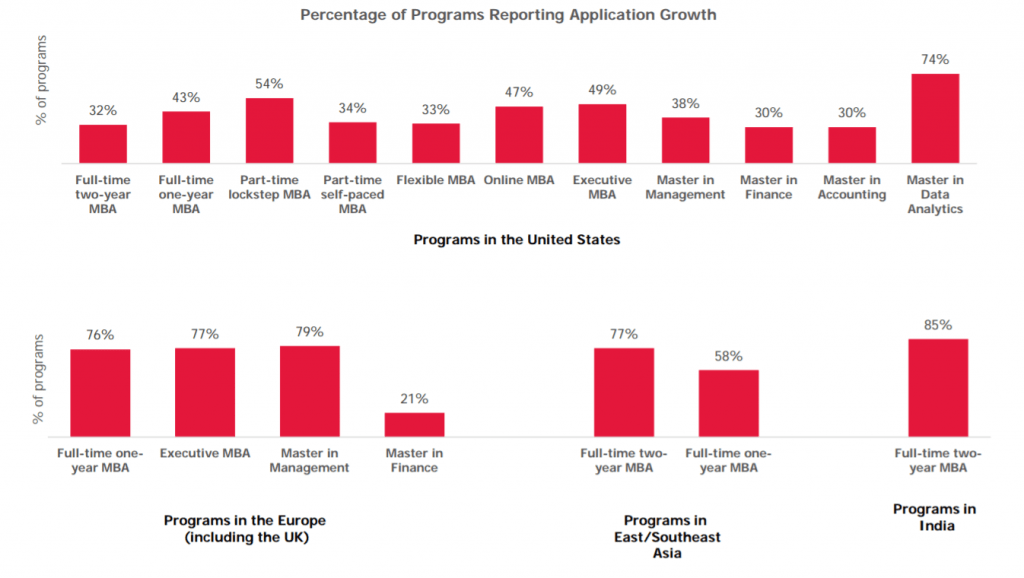Large U.S. graduate business programs—those with more than 200 students—report that times are good. In fact, three in four (73 percent) of these programs saw application volume increase this year, according to the 2017 Application Trends Survey, released yesterday by the Graduate Management Admission Council (GMAC).
But the news is not as rosy for smaller programs. For programs that count 50 students or fewer, only 39 percent saw growth in application volume, while 7 percent remained steady, and 55 percent lost applicants year over year. Overall, among full-time, two-year MBA programs, less than a third (32 percent) of U.S. programs reported application volume gains this year, whereas 64 percent saw application volume decreases. The results mark the third consecutive year in which the majority of U.S. full-time, two-year MBA programs experienced application volume declines. Just three short years ago, those numbers were almost reversed, with 61 percent of U.S. programs reporting application volume increases in 2014.
Elsewhere in the world—including in Europe, East and Southeast Asia, and India—business schools had a very different story to tell. In each of these regions, the vast majority of programs saw application volume increases. In Europe, 76 percent of one-year, full-time MBA programs saw growth; in East and Southeast Asia, 77 percent of full-time, two-year MBA programs saw growth; and in India, 85 percent of full-time, two-year MBA programs reported increased application volume.

A Combination of Factors Chills Overall Demand for U.S. Graduate Business Programs
What gives? Why are business schools around the world seeing such demand for their programs while U.S. schools—with the exception of the largest, best-known schools—faltering?
“Demand for graduate business education remains strong, especially among the largest programs, which also tend to be the most well-known programs with brand recognition,” Sangeet Chowfla, GMAC president and CEO, said in a press release. “While non-U.S. programs are thriving, a strong economy and a disruptive political climate are likely contributing to the downward trend in application volumes among smaller U.S. programs this year.”
Strong Economy Hurts Domestic Application Volume
Citing past GMAC research, the current GMAC report notes that application volume to U.S. graduate business programs frequently runs counter-cyclical to the labor market. When jobs are plentiful, fewer see the need or can justify the opportunity cost of taking time out of the workforce to pursue an advanced degree. This could help explain why only 42 percent of U.S. programs reported growth in the domestic market this year, down from 61 percent in 2016. Exceptions to this trend can be seen in two degree programs, though, according to GMAC. Domestic application volumes grew for more than half of all full-time, one-year MBA programs (54 percent) and Master’s in Data Analytics programs (58 percent).
Trump Rhetoric Takes a Toll on International Applicant Volume
More notable than the decline in domestic applicant volume was the decline in international applicant volume for U.S. programs. Less than a third (32 percent) of U.S. programs saw more international applicants this year than last—down from 49 percent the year before. Master in Data Analytics programs proved the only exception—67 percent of these in-demand programs saw international applications increase.
In fact, for the bigger, better-known U.S. schools that have been largely buffered from overall application volume decline, it’s because domestic applicants have applied in increasing numbers at those schools, offsetting declines in international applicants. According to GMAC, there has been a resurgence of domestic applicants at large programs, with 69 percent reporting increases in this applicant pool this year over last. Of these same programs, only 38 percent saw international application volume increase.
Other regions of the world, meanwhile, may be attracting some of the international applicants that have been giving U.S. programs a wider berth given concerns about potential changes to immigration policies and their impact on visas both for study and for work. According to this latest GMAC survey, twice as many graduate business programs in Europe and Canada saw international application volume increases as did programs in the United States. In Canada, 77 percent of programs reported upticks in international applicants, up from 46 percent in 2016. In Europe, 67 percent of programs saw international application volume growth, a more modest rise over the 65 percent reported there the year before. But even in the United Kingdom, where there was concern that the 2016 Brexit referendum could adversely impact international applicants in some of the same ways that Trump’s election and proposed changes to immigration policy did in the United States, almost two-thirds of programs have wooed more international applicants, not fewer. Notably, graduate business programs depend more heavily on international applicants than on domestic applicants, In Canada, domestic applicants comprised 30 percent of overall applicant volume, and in Europe, just 11 percent.
Women Are Applying to Graduate Business Programs at Record Levels
Another significant finding from the 2017 Application Trends Survey was an increase in women applicants. Women now represent 42 percent of all applications received by the participating programs, up from 37 percent in 2013. Looking specifically at MBA programs, women accounted for 39 percent of applications, a six-point percentage gain since 2013.
Growth in female application volume was most widespread among MBA programs—44 percent saw increases this year over last. Fewer business master’s programs—39 percent—reported increased female applicant volume.
Additional Key Findings
A few other interesting statistics revealed by the most recent survey:
- Overall part-time MBA volume has declined or remained stagnant since the Great Recession. The only exception is part-time lockstep programs, which enroll students in cohorts and provide more of a consistent set of classmates. Of these, 54 percent reported a growth in applications.
- Employer sponsorship remained stable, with approximately 52 percent of part-time students expecting to receive support.
- The experience level of applicants also remained consistent, with the majority of full-time MBA applicants having between three and 10 years of prior work experience.
The Application Trends Survey 2017 reviewed a total of 351 business schools around the global and 965 total graduate business programs—a record for the survey. To see the full results, download the 41-page report.




